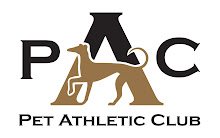ANSON -- A dog is to love. Right?
But it's no fun when it pulls so hard on the leash, it almost yanks your arm out of its socket.
Or when it constantly pushes into your space to get petted, doesn't come when called or growls defensively at the food dish, as it chows down on kibble.
Then, there's destructive behavior, like shredding kitchen trash, when it's left alone in the house. And, how do you handle a rambunctious retriever who jumps all over your non-dog-loving friends?
Hey, who's the boss around here?
That's exactly the question that certified dog trainer Pat Avin of Anson asks of humans whose dogs are acting badly.
"You have to be the top dog. A lot of people can't control their animal," said Avin, whose business is called Pawsitive Motivation. She also works part-time at The Framemakers in Waterville. Her late husband was a computer technician who owned and operated Megabyte Solutions in Madison. She has two grown children.
"I use the path of least resistance; I don't use force. I will use a choke collar in extreme situations. But, I'm not a believer in e-collars (electric shock collars). That's really extreme."
On the other hand, electric "invisible fences" used to keep dogs contained within a designated area are necessary and useful, in certain cases.
"It can keep the dog from harm," she said. An alternative to e-fences is to walk the dog around your boundary line, on a leash.
"You have to do this repeatedly. A behavior becomes a set behavior after 600 to 1,000 times. It's not going to happen overnight."
She can teach a behavior, she said, but the dog owner has to be consistent in applying the behavior in an everyday setting.
"Dogs can't speak English and they can't read minds . . . People holler at a dog, but the dog doesn't know what is expected of them. People make a habit of talking too much. Keep commands simple," she said.
Avin uses behavioral, positive reinforcement techniques.
"I'm a positive trainer," she said.
By way of demonstration, she walked over to her kitchen and rattled a box of dog biscuits. Her three, sweet-tempered, well-behaved, greyhounds -- June Bug, Trixie and Amelia -- which she adopted five years ago from the Maine Greyhound Placement Service Adoption Center in Augusta, soon appeared in the kitchen.
She held a biscuit over June Bug's nose and moved it back over the gray brindle's head. When done correctly, the gesture will get a dog to sit without a voice command.
"It sees the food, and the motion naturally puts them into a seated position. When the dog starts to sit automatically, then you say, 'Sit.' After a while, you can use praise to wean them off the food," she said.
The lean greyhound breed is not really built to sit easily, she noted, which is why it's important to understand your dog's breed.
"Breed is probably the most important consideration. If you want a quiet lifestyle, don't get a Jack Russell. People see the movie '101 Dalmatians' and get a Dalmatian. A lot of Dalmatians are high strung and don't like children."
Once she got a call from a man who owned a wolf/dog hybrid.
"He wanted me to teach it to stop running away, to stay in the yard. This (running) behavior is instinctual. You're not going to keep it from running off. It's what he is. Huskies also run; they have wolf behavior. If you want a dog to hang with you, get a Lab," she said.
She does not work with truly aggressive, mean dogs. These require a specially trained, behaviorist dog trainer. For such cases, she recommended Don Hanson of Green Acres Kennel Shop in Bangor.
Avin received her dog trainer certification in 2006, through an on-line course offered by Animal Behavior College in Northwood, Calif. As part of her hands-on practical, she studied with dog trainer Marie Finnegan of Rockland. Her training also involved work at the Somerset Humane Society in Skowhegan and the Knox County Humane Society in Rockland. And, she has volunteered at the Augusta greyhound placement center, she said.
Sadly, people will often give up on their dogs and take them to animal shelters when they can't control them, she said.
"I like working with dogs and giving them that extra chance."www.greatdogtrainer.com

1 comment:
This is one of the silliest training article ever written.
My favorite quote is "I use the path of least resistance; I don't use force. I will use a choke collar in extreme situations. But, I'm not a believer in e-collars (electric shock collars). That's really extreme."
First, this so called "pawsitive" trainer uses a choke collar. I personally believe training collars DO have a place in dog training, however, this trainer needs to get real. Quit misleading clients. If you are going to use correction, be up front, do not lie about how you train.
Secondly, this person is a very rookie trainer. Learning to train online is very unrealistic. Using a "shock collar" can be a very humane an efficient way of training.
Please educate yourselves so you don't end up going with a trainer like the one in this article.
Post a Comment